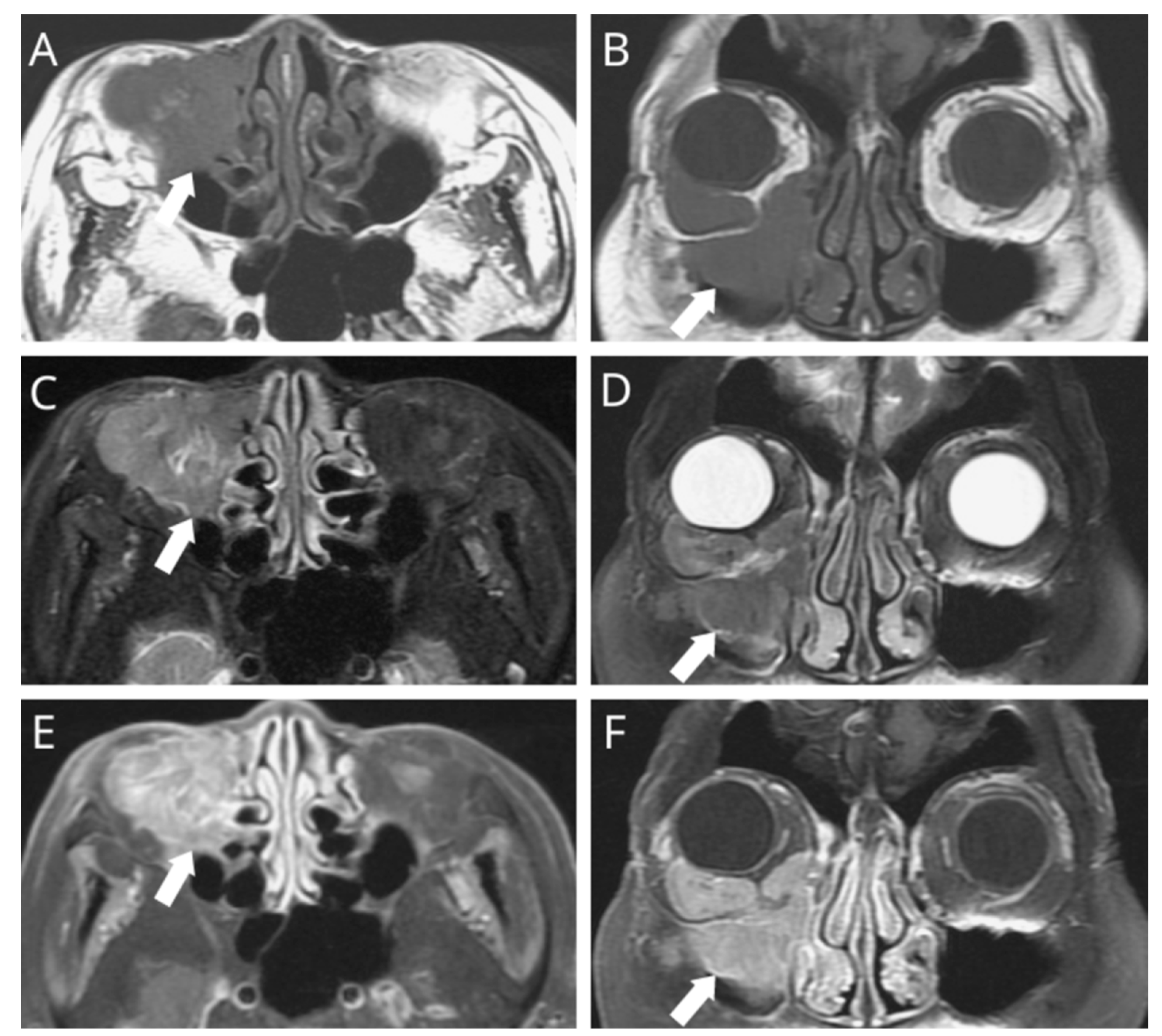Value of 18F-FDG PET/CT for Assessment of Advanced Lacrimal Sac Non-Keratinizing Squamous Cell Carcinoma Successfully Treated with Concurrent Chemoradiotherapy
Abstract
:


Author Contributions
Funding
Institutional Review Board Statement
Informed Consent Statement
Data Availability Statement
Conflicts of Interest
References
- Pilch, B.Z.; Bouquot, J.; Thompson, L.D. Pathology and Genetics of Head and Neck Tumours; Barnes, L., Ed.; IARC Press: Lyon, France, 2005; Chapter 1; pp. 15–17. [Google Scholar]
- Singh, S.; Ali, M.J. Primary Malignant Epithelial Tumors of the Lacrimal Drainage System: A Major Review. Orbit 2021, 40, 179–192. [Google Scholar] [CrossRef] [PubMed]
- Azari, A.A.; Kanavi, M.R.; Saipe, N.; Lee, V.; Lucarelli, M.; Potter, H.D.; Albert, D.M. Transitional cell carcinoma of the lacrimal sac presenting with bloody tears. JAMA Ophthalmol. 2013, 131, 689–690. [Google Scholar] [CrossRef] [PubMed]
- Karim, R.; Ghabrial, R.; Lin, B. Transitional cell carcinoma of the nasolacrimal sac. Clin. Ophthalmol. 2009, 3, 587–591. [Google Scholar] [CrossRef] [PubMed] [Green Version]
- Islam, S.; Thomas, A.; Eisenberg, R.L.; Hoffman, G.R. Surgical management of transitional cell carcinoma of the lacrimal sac: Is it time for a new treatment algorithm? J. Plast Reconstr. Aesthet. Surg. 2012, 65, 33–36. [Google Scholar] [CrossRef] [PubMed]
- El-Sawy, T.; Frank, S.J.; Hanna, E.; Sniegowski, M.; Lai, S.Y.; Nasser, Q.J.; Myers, J.; Esmaeli, B. Multidisciplinary management of lacrimal sac/nasolacrimal duct carcinomas. Ophthalmic. Plast Reconstr. Surg. 2013, 29, 454–457. [Google Scholar] [CrossRef] [PubMed]
- Eweiss, A.Z.; Lund, V.J.; Jay, A.; Rose, G. Transitional cell tumours of the lacrimal drainage apparatus. Rhinology 2013, 51, 349–354. [Google Scholar] [CrossRef] [PubMed] [Green Version]
- Ni, C.; D’Amico, D.J.; Fan, C.Q.; Kuo, P.K. Tumors of the lacrimal sac: A clinicopathological analysis of 82 cases. Int. Ophthalmol. Clin. 1982, 22, 121–140. [Google Scholar] [CrossRef] [PubMed]
- Lane, K.A.; Bilyk, J.R. Preliminary study of positron emission tomography in the detection and management of orbital malignancy. Ophthal. Plast Reconstr. Surg. 2006, 22, 361–365. [Google Scholar] [CrossRef] [PubMed]
- Tafti, B.A.; Shaba, W.; Li, Y.; Yevdayev, E.; Berenji, G.R. Staging and follow-up of lacrimal gland carcinomas by 18F-FDG PET/CT imaging. Clin. Nucl. Med. 2012, 37, 249–252. [Google Scholar] [CrossRef] [PubMed]
Publisher’s Note: MDPI stays neutral with regard to jurisdictional claims in published maps and institutional affiliations. |
© 2021 by the authors. Licensee MDPI, Basel, Switzerland. This article is an open access article distributed under the terms and conditions of the Creative Commons Attribution (CC BY) license (https://creativecommons.org/licenses/by/4.0/).
Share and Cite
Liao, C.-Y.; Huang, L.-A.; Lin, Y.-H. Value of 18F-FDG PET/CT for Assessment of Advanced Lacrimal Sac Non-Keratinizing Squamous Cell Carcinoma Successfully Treated with Concurrent Chemoradiotherapy. Diagnostics 2021, 11, 1961. https://doi.org/10.3390/diagnostics11111961
Liao C-Y, Huang L-A, Lin Y-H. Value of 18F-FDG PET/CT for Assessment of Advanced Lacrimal Sac Non-Keratinizing Squamous Cell Carcinoma Successfully Treated with Concurrent Chemoradiotherapy. Diagnostics. 2021; 11(11):1961. https://doi.org/10.3390/diagnostics11111961
Chicago/Turabian StyleLiao, Ching-Yu, Li-An Huang, and Yu-Hsuan Lin. 2021. "Value of 18F-FDG PET/CT for Assessment of Advanced Lacrimal Sac Non-Keratinizing Squamous Cell Carcinoma Successfully Treated with Concurrent Chemoradiotherapy" Diagnostics 11, no. 11: 1961. https://doi.org/10.3390/diagnostics11111961
APA StyleLiao, C.-Y., Huang, L.-A., & Lin, Y.-H. (2021). Value of 18F-FDG PET/CT for Assessment of Advanced Lacrimal Sac Non-Keratinizing Squamous Cell Carcinoma Successfully Treated with Concurrent Chemoradiotherapy. Diagnostics, 11(11), 1961. https://doi.org/10.3390/diagnostics11111961





